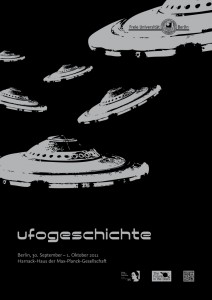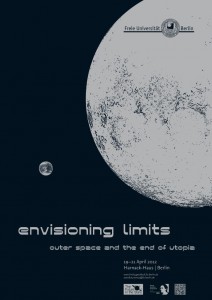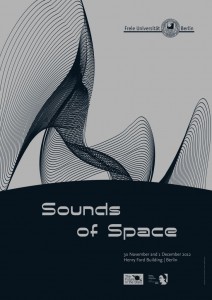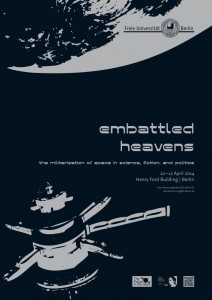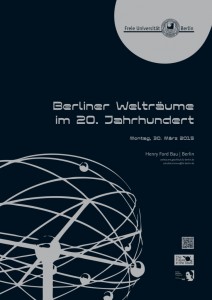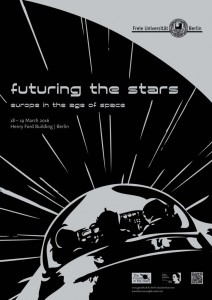L’astroculture européenne, terrain de recherche
L’astroculture européenne, terrain de recherche. Entretien avec Alexander Geppert
Mots-clés : astroculture; Europe; historiographie
Promouvoir l’analyse de la manière dont l’espace est et a été appréhendé par différents groupes ou sociétés et constituer peu à peu une communauté de recherche autour de cet objet figurent parmi les objectifs principaux de ce carnet. Aussi il était naturel pour le premier entretien publié sur le blog de donner la parole à Alexander Geppert qui a, pendant plusieurs années, dirigé un groupe de recherche sur cette question bien précise, à la Freie Universität de Berlin. Les questions, préparées par Catherine Radtka pour Humanités spatiales, reviennent sur la genèse du projet et du groupe « The Future in the Stars », sur les travaux qui ont été réalisés dans son cadre, sur les approches mises en œuvre et leurs liens avec d’autres domaines historiographiques et, enfin, sur les perspectives de recherches qui se dégagent aujourd’hui. Nous laissons les questions et réponses en anglais, pour conserver la franchise des formulations d’Alexander Geppert. Nous ne doutons pas que nos lecteurs apprécieront et qu’ils retireront de cet échange, entre autres choses, une dose d’enthousiasme pour poursuivre leurs propres travaux !
Humanités spatiales: For five years, you have directed a junior research group working on a project named “The Future in the Stars. European Astroculture and Extraterrestrial Life in the Twentieth Century”. On 18 and 19 of March 2016, the group organized the Conference “The Future in the Stars: Europe in the Age of Space” in Berlin. This was the final conference of the Research Group. I would like to take the opportunity of this event to come back in this interview on the genesis of this research group, several aspects of the work that has been done and the prospects you can see now for the study of “astroculture”, especially in Europe.
The project “The Future in the Stars” was funded thanks to the Emmy Noether Program, a program of the German Research Foundation offering the possibility to young researchers to direct their independent junior research group. The project made a break with the historiography on several points. I will mention here only three of them:
(i) the focus on Europe;
(ii) the cultural perspective, which led to the introduction of “astroculture”, a concept designed to refer to the “cultural significance and societal repercussions of outer space and space exploration” ;
(iii) seemingly an independence from space agencies, which have had an important role in the organization and funding of historical works about outer space and space activities.
Could you tell us how you decided to study European space history with this specific cultural approach and how you constituted the group of researchers to do that?
Alexander Geppert (AG): This is something that I am actually being asked quite frequently: Why do you study the cultural history of outer space, and how did you become a space historian? I have several answers. First, the ‘strategic’ one: To continue with but also to depart from my previous work on imperial expositions, the occult and miracles in the nineteenth and twentieth centuries, I was looking for an exciting yet under-explored, potentially even somewhat obscure field at the intersection of twentieth-century cultural history, history of science and technology, and history of knowledge which was in need of being ‘Europeanized’. Then, the ‘intellectual’ answer: At some point during my previous work I had developed a strong interest in concepts of spatiality, at that time controversially debated under the catchphrase “spatial turn”, when I began to wonder whether it would be feasible to radicalize this turn by applying it to the largest spatial object conceivable, outer space. Last but not least, the personal answer: I really do not know. Like many of us, over the years my historiographical intuition has been trained and trained, and at some point I just sensed that I had found the exciting subject matter that I was looking for – or rather, that it had found me.
With regard to the setup of the group: Technically, it has been six years. Having written an extensive grant proposal while at Harvard in 2007–09, the Deutsche Forschungsgemeinschaft (DFG) awarded me an Emmy Noether grant in January 2010, worth €1.2 million, to be spent over the course of five years. This is the most valuable award for early career researchers in Germany and comparable to an ERC Starting Grant (which was actually modeled on the Noether program). The idea is to offer an alternative to the traditional professorial track requiring the so-called Habilitation by giving young academics the opportunity to achieve the qualifications required for a university career by directing an independent research group composed of several PhD students and postdocs over the course of five years. Since I very much believe in transparency, diversity and internationalism, and loathe any kind of wheeling and dealing, none of the positions I could then offer were previously occupied, so I had to advertise them widely, invite potential candidates to Berlin and interview them – a elaborate yet absolutely worthwhile process. Finally, the group was complete by fall 2010, and we started working. Ever since we have convened at least one public event per year, trying out different forms and formats at the same time. These events included the large-scale film retrospective Weltraumkino consisting of 25 historical space movies screened in Berlin in April and May 2011; a workshop Ufogeschichte on the history of UFOs held in September 2011; an international symposium Envisioning Limits: Outer Space and the End of Utopia on 1970s astroculture in April 2012; a workshop Sounds of Space in November 2012; another large-scale conference Embattled Heavens: The Militarization of Space in Science, Fiction and Politics in April 2014; a workshop on sites of space in Berlin entitled Berliner Welträume in March 2015; and, last but not least, now the final and, alas, concluding conference Futuring the Stars: Europe in the Age of Space.
Humanités spatiales: It seems to me that the project “The Future in the Stars” has been a catalyst of both individual and collective works: PhD projects have been conducted within this framework as well as post-doctoral studies. Moreover, the program also echoes the research interests of other researchers. Publications that derive directly from the project actually reflect these connections. For instance, the book Imagining Outer Space includes contributions written by the former Chief Historian of the NASA, Steven J. Dick, or by the sociologist Pierre Lagrange. This results in a collection of very diverse essays. Even though they are linked together through the concept of “astroculture”, these essays remain quite eclectic: space pictured in different media (comic strips, news stories, but also science fiction literature), various presentations of extraterrestrial life and approach of different scientific communities to this question (UFOs, sociologists’ relation to stories including ETs, research programs considering the possibility of such a life…), or even the conception of time and space in history and the way it can be influenced by space research. It was also to a lesser extent the case in the volume of History and Technology published in 2012. It seems that the great diversity of objects and sources that can be analyzed in the perspective of an historicization of the cultural meanings of space shows the fruitfulness of the concept of “astroculture” and is, in the meantime, a real challenge. How did you manage to keep a clear line of research during this project and to integrate the different individual contributions? How would you describe the main benefits of the research program the “Future in the Stars”?
AG: Yes, I do certainly agree with such an observation. Conducting, choreographing and coordinating collective work while pursuing our individual research projects has been one of the overarching goals right from the beginning. The book and journal issue that you mention were a first tangible product of that work. A paperback edition of Imagining Outer Space will be re-issued shortly; it will be followed by two companion volumes identical in form and format, Limiting Outer Space: Astroculture After Apollo and Militarizing Outer Space: Astroculture, Dystopia and the Cold War, both under contract with Palgrave Macmillan and very loosely based on the conferences Envisioning Limits and Embattled Heavens previously mentioned . While Imagining Outer Space set out to establish and contour a new field of historical inquiry – ‘astroculture’ –, the scope of the two forthcoming books are more limited, yet also more focused. Limiting Outer Space zooms in on a single decade in the history of imagining, thinking and practicing outer space, the crisis-ridden 1970s, and foregrounds one particular problem, the limits of utopian thought and practice during this aptly called post-Apollo period. The third volume, Militarizing Outer Space: Astroculture, Dystopia and the Cold War, will conclude the trilogy on by exploring the militant dimensions of outer space in science fiction and science fact and thus expose the ‘dark’ side of global astroculture. What all three volumes have in common is a cultural-interpretative approach, a commitment to combining a multiplicity of disciplinary perspectives into a coherent whole, the intention to push space history’s geographical focus beyond the borders of the two Cold War superpowers, in particularly by inscribing Western Europe, and, above all, the concept of astroculture. That said, there was not any kind of master plan behind the production of these three books which is why I call them an ‘unintended trilogy’ on astroculture and space thought, as they were guided by a responsive, step-by-step approach.
Humanités spatiales: More generally, what are, for you, the main results and findings of the program?
AG: For that you will have to read my long epilogue to the third of the forthcoming volumes, I am afraid ;-), where I answer precisely that question en détail: What have we achieved, what not? What has this all been good for, where are we now, what’s next? But I am obviously happy to list a few major findings and arguments, even if somewhat provisionally. First, outer space was a technoscientific key project and prototypical product of the twentieth century. Outer space has constantly been made and remade. It was produced and consumed, made real and became ever more spatial, if you will, by adding sites and places both in ‘science’ and in ‘fiction’. Simultaneously active and passive, it was far more than just an escapist projection foil for terrestrial fantasies of colonial expansion, but rather the place where imaginary futures were played out. Second, the existence of widespread debates on outer space both among experts and in the various West European publics testify to its far-reaching significance as an imaginary lieu de l’avenir, even outside spacefaring nations. This has us led, third, to deemphasize the conventional Cold War context and to suggest new periodizations instead, in particular with regard to what is commonly called the Space Age. Fourth, while we have tried everything possible to ‘Europeanize’ the historicization of space as forcefully as possible, we have not been able to do so systematically, not the least due to a lack of ‘manpower’. Which is another reason why I am grateful for the existence of humanités spatiales as there is still an enormous amount of work to be done. Finally, ‘astroculture’ has indeed proven an excellent conceptual tool as it allows to overcome static and long overwrought dichotomies. Trying to discriminate between, say, ‘science’ and ‘fiction’, or ‘popular’ and ‘elite’, is not only bound to fail but also pointless. Outer space derives its continual fascination from being both at the same time.
Humanités spatiales: There are several themes and historical issues that connect with the research conducted by your group. The most obvious is maybe space history but I wonder whether that is the most productive and intellectually stimulating. I mean: it is possible to consider the work on “Europe in space” as an extension of space history which has also known a “cultural case” (be it for the American or Soviet/Russian contexts) – and it is also more than possible: it is certainly necessary. But the subject also refers to the cultural place of technology or, to say it in another way, to the public engagement with technoscientific objects. Because outer space is related to many utopian projects and visions of futures, it also refers to social perception and appropriation of time. This thread could lead to connections with the study of modernity. Another comprehensive (and broad) theme would be the social perception and experience of the universe.
What kind of connections did the members of the group make with other fields in history to study such an encompassing object? Would you consider that Outer Space keeps some specificity, compared with other themes? Can historicizing the space age shed new light on the history of the Twentieth Century in Europe?
AG: Another great question, thanks so much for so many very astute observations. Yes, that has been and still is yet another challenge of our collective and everybody’s individual work, to maintain the specificity of outer space while demonstrating its centrality to the twentieth century. While we have tried to establish and legitimize a new research field and thus to de-exoticize the study of outer space, we have, at the same time, also been very eager to ‘mainstream’ it. Thus, every event that we put on and every publication that we have put out has tried to engage with and intervene into recent historiographical debates, be it on the ‘long 1970s’, the sonic dimension of history, forms of direct and indirect violence, or even local urban history.
The idea to connect the study of space with the competing versions of the twentieth century’s futures in particular and the history of time and temporality is one in which I am myself particularly interested. To that extent, I have just published a long research article (which forms part of my forthcoming book) on time in the age of space, ca. 1942–1972. It poses precisely the question that you are suggesting, in three different takes: first, when was the Space Age, understood as a significant (but now past) period in human history; second, what kind of temporal orders were inherent in West-European space thought; and, third, how has the experience of time on board spaceships been described by astronauts and cosmonauts themselves? The punchline is that the third question helps to answer the second, and the second then in turn the first. Because the continued physical exploration of space had hardly any effects on everyday notions of temporality, promises of future expansion were no longer believed in the post-Apollo period. When the space/future connex broke away in the 1970s because the cultural resonance of spaceflight remained limited once earlier promises had proved impossible to fulfill, the Space Age was over, at least in the West, even if spaceflight as such obviously continues to this very day. The climax of the Space Age was tantamount to its endpoint; hence it lasted precisely three decades, from the first A-4 launch on 3 October 1942 to the last man leaving the moon on 14 December 1972 .
Humanités spatiales: The project “The Future in the Stars” is now coming to an end. Apart from the work which derives from it (there are forthcoming publications and maybe the final conference will also lead to the publication of a collective volume), what future do you see for the concept of “astroculture”? And for the study of European culture(s) of space? Can there be a follow-up to the research group?
AG: There must and there will be. Three years ago I applied to one of the European Research Council’s Consolidator Grants for precisely that reason, to establish a follow-up project that would allow me to continue with this kind of research and perpetuate the international and transdisciplinary community of scholars interested in space (including historians; historians of science and technology; art historians; scholars of religion, literature; sociologists; geographers; political scientists; philosophers and many other disciplines) that we have successfully established over the years. The project was entitled “Transcending Earth: Outer Space and the Making of the Global Age, 1942–1990”, and once again the idea was similar and different at the same time: to historicize outer space from a world-encompassing perspective and to analyze its significance for the making of a global age. Why is it that not only in the USSR, the USA and Europe, but also in Japan, China and India the historical anticipation of spaceflight was so intimately bound with futuristic visions of human progress that space and spaceflight became the epitome of technoscientific modernity?
Unfortunately, only four of the five reviewers were in favor of funding it, but the fifth one apparently thought I had lost my marbles and gone nuts. And since these big grants are as competitive as they should be, such a vote meant that I was instantly out. Rather than going through the entire process again and reapplying the next year, I accepted a well-resourced position as associate professor of European history at New York University, a joint appointment at NYU’s new campus in Shanghai and the Center for European and Mediterranean Studies in Manhattan, with an affiliation to the History Department in New York on top. In that capacity I very much intend to continue working in the field and try to globalize – or better: planetize – the study of astroculture, in particular by integrating China, India and Japan into the account – but geographically this is more likely to take place in Shanghai and New York rather than in Berlin, where it all began.
Entretien réalisé par Catherine Radtka
1 Alexander C. T. Geppert, “European Astrofuturism, Cosmic Provincialism”, in ibid. (ed.) Imagining Outer Space. European Astroculture in the Twentieth Century, Basingstoke: Palgrave Macmillan, 2012, citation p. 8.
2 Alexander C. T. Geppert (ed.) Imagining Outer Space. European Astroculture in the Twentieth Century, Basingstoke: Palgrave Macmillan, 2012, (paperback edition forthcoming spring 2017); idem (ed.), Limiting Outer Space: Astroculture After Apollo, London: Palgrave Macmillan (forthcoming spring 2017); Alexander C. T. Geppert, Daniel Brandau and Tilmann Siebeneichner (eds), Militarizing Outer Space: Astroculture and Dystopia in the Cold War, London: Palgrave Macmillan (forthcoming fall 2017).
3 Alexander C. T. Geppert, „Die Zeit des Weltraumzeitalters, 1942–1972“, in idem and Till Kössler (eds), Obsession der Gegenwart: Zeit im 20. Jahrhundert, Göttingen: Vandenhoeck & Ruprecht, 2015 (= Geschichte und Gesellschaft. Sonderheft 25), pp. 218–50.
